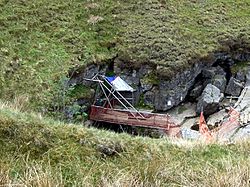Jib Tunnel facts for kids
Quick facts for kids Jib Tunnel |
|
|---|---|

The entrance is between the rock wall and the large boulder
|
|
| Location | Ingleborough, North Yorkshire, UK |
| OS grid | SD 7510 7270 |
| Depth | 98 metres (322 ft) (To floor of Gaping Gill Main Chamber) |
| Length | 100 metres (330 ft) (including Spout Tunnel) |
| Elevation | 396 metres (1,299 ft) |
| Discovery | 1872 |
| Geology | Carboniferous limestone |
| Entrances | 1 |
| Difficulty | IV-V |
| Hazards | water, verticality |
| Access | Permit |
| Cave survey | 1976 CPC Survey on Cave Maps |
Jib Tunnel, also known as Lateral Passage, is one of the ways into the amazing Gaping Gill cave system. You can find it behind a large rock on the north bank of Fell Beck, right next to the Gaping Gill Main Shaft. Even though it's a short tunnel, it leads to Lateral Shaft, which drops straight down into the Gaping Gill Main Chamber. This makes it a popular route for cavers. Jib Tunnel has played a big part in the history of exploring Gaping Gill. It's also located within a special natural area called the Ingleborough Site of Special Scientific Interest.
Contents
Exploring Jib Tunnel
To get into Jib Tunnel, you need to squeeze between a rock wall and a large boulder. After about 5 metres (16 ft), the passage suddenly drops 98 metres (322 ft) to the floor of the Main Chamber. This is a huge drop!
The Dihedral Route
A lot of water comes down from Spout Tunnel, about 12 metres (39 ft) below the entrance. Because of this, cavers usually take a different path called Dihedral. This route avoids the main waterfall. It lands on a ledge about 50 metres (160 ft) down. From there, cavers leave the main shaft and drop down a crack above the Main Chamber. Finally, they come out through the roof and drop the last 30 metres (98 ft) to the chamber floor.
Discovering Spout Tunnel
You can enter Spout Tunnel by swinging in from a rope or ladder. The passage gets narrow. After about 37 metres (121 ft), the main water enters down a 9 metres (30 ft) pitch (a steep drop). Above this pitch, a 3 metres (9.8 ft) climb leads to 49 metres (161 ft) of passage. This passage gets too small near a sink in Fell Beck, across from Rat Hole Sink. Below the pitch, a small passage continues for another 25 metres (82 ft). Experts think this passage drains the area just east of the blind valley.
History of Jib Tunnel Exploration
Professor McKenny Hughes said that the entrance to Jib Tunnel was blocked by dirt and rocks until a big flood in 1872. The flood washed out the blockage. He then squeezed past the large boulder and reached the shaft, which he thought was more than 90 metres (300 ft) deep.
Early Attempts and Success
In 1895, Edward Calvert from the Yorkshire Ramblers' Club tried to go down the Main Shaft. He wanted to do what Edouard Martel had done a few weeks earlier. But he couldn't get past Birkbeck's Ledge, about −60 metres (−200 ft) down, because there was too much water. Looking up, he saw that the shaft split behind a curtain of rock.
Later that year, Calvert entered Jib Tunnel. He realized this was the parallel shaft he had seen. He understood that someone could be lowered directly to the Main Chamber floor from Jib Tunnel's entrance. The next year, he set up a system of jibs and pulleys. He was lowered in a special seat, becoming the second person ever to reach the Main Chamber.
Changing Exploration Methods
Jib Tunnel was used for exploring the Gaping Gill system until 1921. That's when a new system was developed. A winch was lowered from a gantry (a frame) placed across the corner of the Main Shaft. This made it easier to explore the cave.
Safety in Caving
Caving can be a dangerous activity, and it's very important to be careful and well-trained. Over the years, some accidents have happened in Jib Tunnel, showing how important it is to follow safety rules and have experienced guides. Always remember that exploring caves requires great care and respect for the environment.

